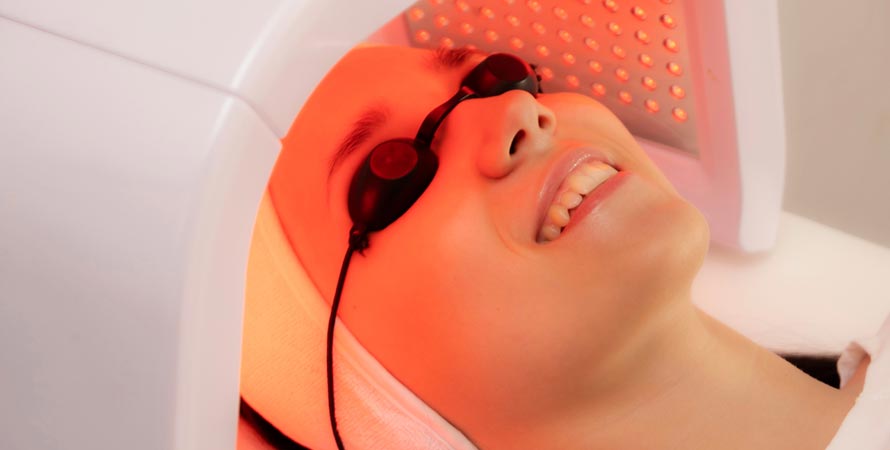The Ultimate Guide to LED Light Therapies for Skin

- LED light therapy for the face is growing in popularity worldwide as a way of potentially treating skin issues.
- Light therapy is usually conducted under the supervision of a dermatologist or an aesthetician, but this is changing rapidly.
- LED light therapy uses red light to produce different effects on the skin, which may improve the texture and appearance of the overall surface of the facial skin.
- Light therapy can be used to treat and improve the appearance of acne, scarring, and sun damage on the surface of the skin.
- The LED light therapy benefits can be better than the traditional methods of improving skin conditions.
- LED light therapy is becoming more attainable as its popularity increases as an alternative way to treat skin conditions.
Introduction
LED light therapy for the face is growing in popularity worldwide as an alternative method of helping to improve the look and texture of the skin. The procedure treats and improves some common skin conditions that some people wish to have changed, such as acne, scarring, and damage caused by sun exposure.
LED light therapy is non-invasive and usually carried out by a dermatologist or aesthetician under clinical guidance. However, this is changing as technology advances and treatments become more obtainable.
LEDs have been used for many decades in many areas. However, only recently have they made their way into the skincare sector, and this is mainly due to the light therapy being considered incredibly safe for use as it does not cause burns, nor does it emit UV rays.
Although it is incredibly safe for the majority of people, it is always recommended to speak to a professional before commencing any new skincare procedure or regimen.
This guide will give you all the information you need to make an informed decision on whether LED light therapy may be an option for you, so let’s have a look at what the treatment involves, how it can help you and what the LED light therapy benefits are!
What Is LED Light Therapy?
LED Light Therapy or Phototherapy works by using a device that has LEDs within its structure. This device can direct infra-red light through the device to the area that needs treating.
The LED light is delivered to the area to be treated in varying degrees of light waves by a professional dermatologist, aesthetician, or qualified skin consultant. LED light therapy benefits skin conditions such as scarring, acne, uneven skin tone, and sun damage, thus possibly improving the appearance and texture of the skin.
How Does LED Light Therapy Work?

LED light therapy is thought to assist in the rejuvenation of the skin’s deeper layers, which will promote a fresher looking appearance to the skin by potentially improving the appearance of skin conditions, such as:
- Acne
- Rosacea
- Scarring
- Uneven Skin tone
- Sun Damage
- Age Spots
- Wrinkles
One of the reported LED light therapy benefits is that the waves of light can penetrate deeper into the layers of the skin.
It is said that the light waves that are emitted will work to stimulate circulation, increase the production of collagen, and have a positive effect on the structures of fibroblasts within the skin’s deeper layers.
What Different Kinds of LED Light Therapy Are Available?
There are two primary variations of LED light therapy named after the color of light they emit, red or blue.
The color of light in the LED light therapy can change the treatment uses, so the benefits also vary depending on which treatment is more suitable for you.
Here’s the difference between the two types:
1. Red light therapy
Red light therapy can potentially create positive effects on the collagen within the skin layers.
Collagen is the naturally occurring protein within the skin, but its reproduction rate can slow with the aging process and get interrupted through damage to the skin and skin conditions. Having optimum collagen levels will help the skin heal and look more youthful and rejuvenated.
Red light therapy can assist in increasing stimulation to the skin, which could, in turn, increase collagen production and skin cell turnover. This process could help treat inflammation of the skin, the effects of aging, such as fine lines and wrinkles, and possibly improve the appearance of acne and psoriasis.
2. Blue light therapy
Blue light therapy for skin care has been shown to reduce the sebaceous activity within the skin’s pores.
Oily skin types may be more predisposed to developing acne and irregular skin texture as sebum production is higher than the normal skin type. It is a contributing factor to the appearance of acne blemishes and spots.
Blue light therapy could reduce sebum production and improve the appearance of spots and acne. However, there is no guarantee this treatment will completely eradicate these skin conditions.
This treatment may also help with the destruction of bacteria that can also cause acne, which may improve the appearance of the skin, the texture of the skin for current and previous acne flares, and potentially reduce the recurrence of acne flares.
What Is the Price of LED Therapy?
The price of LED therapy can vary across the world and different providers. Still, as a rough ballpark figure, you will need to set aside between $150- $300 for a course of LED therapy from a dermatologist or aesthetic clinic.
Courses of in-clinic LED light therapy for the face can range from 8-15 visits for treatment, depending on the reasons for treatment, the severity of the skin condition, and how the progress goes of the subsequent treatments.
LED therapy at home can range from $350- $500, and this will be the price of the mask specially built for facial LED treatment that can be conducted in your own home.
What Are the Benefits of LED Therapy?

LED therapy could help to improve the appearance of the skin on the face, and there are many other LED light therapy benefits, such as:
- Improving the visual appearance of fine lines and wrinkles
- Making the facial skin look more even and rejuvenated
- Helping the healing process of lesions and scarring
- Reducing the appearance of pigmentation from skin damage or age spots
- Improving the circulation to the facial skin
- Reducing the appearance and recurrence of skin conditions such as acne and psoriasis
- Can reduce inflammation in the skin, relieving swelling and redness.
How Is LED Light Therapy Carried Out?
LED light therapy for the face is carried out in the same way at home as in a clinic or medical setting.
The face is washed with a gentle cleanser that does not irritate the skin. An all-natural product that you have used before is best for this, to make sure the face is free of daily buildup, makeup, and any excess oils on the skin before the treatment.
You will more than likely have the red light therapy or blue light lying down in an office, or if you are at home, you can choose how you are comfortable!
The practitioner will provide you with some eye protection, as the lights can be pretty bright to the naked eye. You will either have a complete mask device placed over your whole face for treatment. Another way is the aesthetician will hold a hand-held device over your face in places and control the waves of light and where they go.
You may feel a warming sensation of heat after a few moments of the waves being directed over the skin, which is quite normal. After 15-20 minutes, your treatment will be completed!
Are There Any Risk Factors or Side Effects?
LED light therapy for the face is a non-invasive treatment and has been deemed safe for all skin colors, types, and conditions.
Although deemed safe, you should proceed with caution and receive full professional consultation to determine if LED light therapy for the face is correct for your skin needs.
If your skin is particularly sensitive to heat or your skin is in a severe condition, a professional may advise you against this treatment until you can improve the skin condition significantly via other methods.
You may experience a residual sensation of heat in your skin after treatment. Still, if this lingers for too long or gets worse in any way, you should consult a medical professional immediately for further advice.
Any stinging, tightening, or burning sensations in the skin during the treatment, which is rare according to the treatment profile, stop the treatment immediately for investigation and recovery.
Conclusion
Overall, LED light therapy for the face and other LED treatments can be beneficial in treating skin conditions such as cystic acne and psoriasis and may help reduce the signs of aging.
The red light therapy, as well as the blue light, can be beneficial for improving the texture and tone of the skin. They may also help to increase collagen production and kill the bacteria that causes acne and significant recurrent blemishes.
LED light therapy is usually recommended in a course, and this will be related to the condition or skin complaint and the severity of the condition.
As we have seen, in a clinic or at home, therapies can be pricey and are not always guaranteed to work or show any improvement, but there is also the possibility that the LED light therapy may just be the proper treatment for you.
Deprecated: Function WP_Query was called with an argument that is deprecated since version 3.1.0!
caller_get_posts is deprecated. Use ignore_sticky_posts instead. in /home/healthwebmagazin/skinformulations.com/wp-includes/functions.php on line 6121






